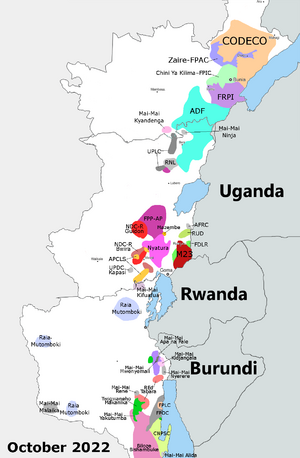Kivu conflict facts for kids
The Kivu conflict is a long-lasting series of fights happening in the eastern part of the Democratic Republic of the Congo. These fights take place mainly in the North Kivu and South Kivu provinces. They started after a big war called the Second Congo War ended.
Many different armed groups are active in this area, sometimes more than 120! Some of the main groups fighting include the Allied Democratic Forces, the Cooperative for the Development of the Congo, the March 23 Movement (M23), and many local groups called Mai Mai militias.
The government's army, known as the FARDC, is also involved. Besides them, international groups like the United Nations (UN) with their MONUSCO peacekeeping force, and a regional force from the East African Community, have stepped in to try and help.
The conflict generally has three main parts. The first phase started in 2004. At first, the main group fighting against the FARDC was the National Congress for the Defence of the People (CNDP). After 2009, other rebel groups, especially those linked to the Tutsi ethnic group, became the main opposition. The third phase of the conflict is still going on today.
Quick facts for kids Kivu conflict |
|||||||||
|---|---|---|---|---|---|---|---|---|---|
| Part of the aftermath of the Second Congo War | |||||||||
|
Approximate map of current military situation in Kivu. |
|||||||||
|
|||||||||
| Belligerents (see full list) | |||||||||
|
Rwandan-aligned militias: Ugandan-aligned militias:
Foreign state actors: |
Pro-government:
Supported by: |
Anti-Ugandan forces:
Anti-Rwandan militias:
Anti-Burundi militias:
|
Mai-Mai militias:
|
||||||
| Commanders and leaders | |||||||||
|
|
||||||||
| Strength | |||||||||
| 6,000–8,000 CNDP (2007) 5,500+ M23 (2012) |
2004: 20,000 total troops; 2008:
2013: 22,016 UN Monusco Uniformed personnel (2013) |
2,000 FDLR 3,000 FNL/Palipehutu Hundreds of FNL–Nzabampema |
Several thousand Raia Mutomboki militia 10,000+ other armed groups 1,500 ACPLS |
||||||
| Casualties and losses | |||||||||
| CNDP: 233 killed | FARDC: 71 killed BDF: Unknown |
Unknown | Unknown | ||||||
| More than 1.4 million internally displaced persons, hundreds of thousands of excess deaths, 11,873+ people killed (including civilians and combatants of each sides) |
|||||||||
Contents
Who is Fighting in Kivu?
The main groups involved in the Kivu conflict are the government's army (FARDC) and many rebel groups. One important rebel group is the Democratic Forces for the Liberation of Rwanda (FDLR). This group is made up of people from the Hutu ethnic group.
The National Congress for the Defence of the People (CNDP) was another major group. They supported the Banyamulenge people, who are an ethnic Tutsi group in Eastern Congo. The CNDP also had ties to the Tutsi-led government in neighboring Rwanda.
What Has the United Nations Done?
The United Nations Mission in the Democratic Republic of Congo (MONUSCO) plays a very big role in trying to bring peace. It is one of the largest peacekeeping missions in the world, with thousands of soldiers.
These peacekeepers work to stop the fighting from getting worse. Sadly, many peacekeepers have lost their lives trying to protect people in the region. For example, 15 peacekeepers died in a large attack in 2017.
Why is the Conflict Happening?
The conflict is very complex, with many different reasons for the fighting. These include disagreements between ethnic groups like the Hutu and Tutsi. Also, control over valuable natural resources in the region, like minerals, plays a part.
A report from the United Nations in 2024 mentioned that some countries might be involved in supporting different groups. The report also highlighted serious problems caused by the fighting. These problems include:
- Children being forced to become soldiers.
- Violence against regular people.
- Stealing and looting.
- Illegal mining of resources.
- Corruption.
Impact on People
The Kivu conflict has had a terrible impact on the people living in the region. More than 1.4 million people have been forced to leave their homes and move to safer areas. They are called "internally displaced persons."
Many people have also died because of the conflict, including both fighters and innocent civilians. The ongoing violence makes life very difficult and unsafe for families in Eastern Congo.
Images for kids
See also
 In Spanish: Guerra de Kivu para niños
In Spanish: Guerra de Kivu para niños
- Ituri conflict
- List of conflicts in Africa





